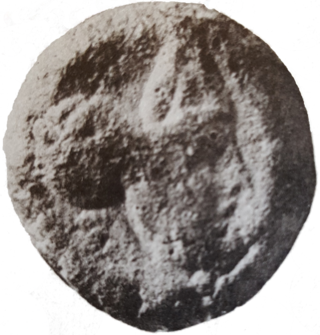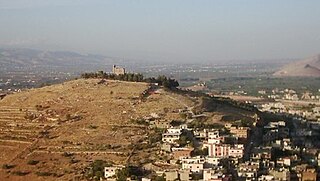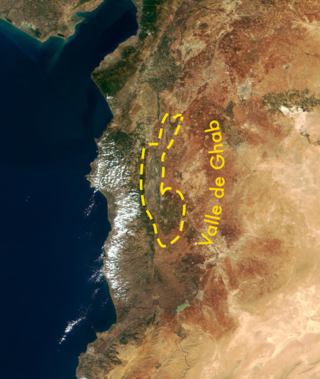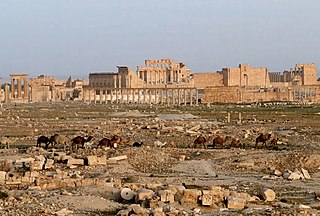Related Research Articles

Septimia Zenobia was a third-century queen of the Palmyrene Empire in Syria. Many legends surround her ancestry; she was probably not a commoner and she married the ruler of the city, Odaenathus. Her husband became king in 260, elevating Palmyra to supreme power in the Near East by defeating the Sasanian Empire of Persia and stabilizing the Roman East. After Odaenathus' assassination, Zenobia became the regent of her son Vaballathus and held de facto power throughout his reign.

Septimius Odaenathus was the founder king (Mlk) of the Palmyrene Kingdom who ruled from Palmyra, Syria. He elevated the status of his kingdom from a regional center subordinate to Rome into a formidable state in the Near East. Odaenathus was born into an aristocratic Palmyrene family that had received Roman citizenship in the 190s under the Severan dynasty. He was the son of Hairan, the descendant of Nasor. The circumstances surrounding his rise are ambiguous; he became the lord (ras) of the city, a position created for him, as early as the 240s and by 258, he was styled a consularis, indicating a high status in the Roman Empire.

The Beqaa Valley, also transliterated as Bekaa, Biqâ, and Becaa and known in classical antiquity as Coele-Syria, is a fertile valley in eastern Lebanon. It is Lebanon's most important farming region. Industry also flourishes in Beqaa, especially that related to agriculture.

The Emesenedynasty, also called the Sampsigeramids or the Sampsigerami or the House of Sampsigeramus, were a Roman client dynasty of Arab priest-kings known to have ruled by 46 BC from Arethusa and later from Emesa, Syria, until between 72 and 78/79, or at the latest the reign of Emperor Antoninus Pius (138–161). Iamblichus, the famous Neoplatonist philosopher of the third century, was one of their descendants, as was empress Julia Domna, matriarch of the Severan dynasty.

Halabiye is an archaeological site on the right bank of the Euphrates River in Deir ez-Zor Governorate, Syria. It was an ancient city and former bishopric known as Zenobia and a Latin Catholic titular see.

Aureliano in Palmira is an operatic dramma serio in two acts written by Gioachino Rossini to an Italian libretto in which the librettist was credited only by the initials "G. F. R." The libretto has generally been attributed to Felice Romani, but sometimes to the otherwise unknown Gian Francesco Romanelli. It has been suggested that the latter name may have resulted from a confusion of Romani with Luigi Romanelli, La Scala's house poet prior to Romani's appointment to the post.

The Beirut River is a river in Lebanon separating the city of Beirut from its eastern suburbs, primarily Bourj Hammoud and Sin el Fil. The river flows mostly east to west from snow drains and springs on the western slopes of Mount Kneisseh and the southern end of Mount Sannine near the towns of Hammana and Falougha, before curving north and emptying at Beirut's northern Mediterranean coast, east of the Port of Beirut. According to popular legend, St. George slew the dragon in a spot near the mouth of the river.
The Harbaqa Dam or Kharbaqa Dam was a Roman era Palmyrene gravity dam in the Syrian desert about 70 kilometres (43 mi) southwest from Palmyra on the road to Damascus. The dam, built of rubble, concrete, and dressed with ashlar stones, dates to the first or second century AD. The dam later was used as a water supply for the Umayyad palace of Qasr al-Hayr al-Gharbi.

The Ghab Plain is a fertile depression lying mainly in the Al-Suqaylabiyah District in northwest Syria. The Orontes River, flowing north, enters the Plain near Muhradah, around 25 km north-west of Hama.

Labweh, Laboué, Labwe or Al-Labweh is a village at an elevation of 950 metres (3,120 ft) on a foothill of the Anti-Lebanon Mountains in Baalbek District, Baalbek-Hermel Governorate, Lebanon.

Maqne or Maakne is a town and municipality in Baalbek District, Baalbek-Hermel Governorate, Lebanon.
Arsal, is a town and municipality situated east of Labweh, 124 kilometres (77 mi) northeast of Beirut, in Baalbek District of Baalbek-Hermel Governorate, Lebanon. The population is predominantly Sunni Muslim.

Kamouh el Hermel, the Pyramid of Hermel is an ancient pyramid located 6 kilometres (3.7 mi) south of Hermel in Baalbek-Hermel Governorate, Lebanon.
The Monastery of Saint Maron, also called the Cave of the monks, is an ancient cavern initially developed as a refuge structure by the Romans and later used as a Maronite monastery and carved out of solid rock in the side of a cliff. It is located around 200 metres (660 ft) from Ain ez Zarqa, the source of the Orontes river, south of Hermel in Baalbek-Hermel Governorate, northern Lebanon.

Yammoune is a lake, nature reserve, village and municipality situated 27 kilometres (17 mi) northwest of Baalbek in Baalbek District, Baalbek-Hermel Governorate, Lebanon. The village has a few hundred inhabitants.

The al-Qusayr offensive was an operation by the Syrian Government forces against Opposition forces at al-Qusayr in Homs province, during the Syrian Civil War. The operation was launched on 4 April 2013. The Syrian Army, the Lebanese militia Hezbollah and the National Defense Forces played key roles in the attack. Its aim was to capture all villages around the rebel-held town of al-Qusayr, thus tightening the siege of the city and ultimately launching an attack on al-Qusayr itself. The region was an important supply route for rebels fighting Syrian government forces in Homs.

Palmyra is an ancient city in the eastern part of the Levant, now in the center of modern Syria. Archaeological finds date back to the Neolithic period, and documents first mention the city in the early second millennium BC. Palmyra changed hands on a number of occasions between different empires before becoming a subject of the Roman Empire in the first century AD.

Septimius Herodianus or Hairan I was a son and co-king of Odaenathus of Palmyra. Through his father's marriage to Zenobia, Hairan I had two half-brothers, Hairan II and Vaballathus.

Phoenice Libanensis, was a province of the Roman Empire, covering the Anti-Lebanon Mountains and the territories to the east, all the way to Palmyra. It was officially created c. 394, when the Roman province of Phoenice was divided into Phoenice proper or Phoenice Paralia, and Phoenice Libanensis, a division that persisted until the region was conquered by the Muslim Arabs in the 630s.
References
- 1 2 3 Michel M. Alouf; Tedd St Rain (1999). History of Baalbek. Book Tree. pp. 43–. ISBN 978-1-58509-063-1 . Retrieved 1 October 2012.
- ↑ Roman bridge over canal supposed to be built under Zenobia
- 1 2 Halim Said Abu-Izzeddin (1963). Lebanon and its provinces: a study by the governors of the five provinces. Khayats. Retrieved 1 October 2012.
- ↑ Guadagnoli, Giulia, Hermel - Survey of social and economic establishments in 5 municipalities, MADA, January 2009 [ permanent dead link ]
- ↑ Sahili, Jamal., (Translated by Lynn Waked), Hermel, The wealth of ancient monuments, Lebanese National News Agency, 24 November 2010. [ permanent dead link ]
- ↑ Palmira (in Italian)
- ↑ Ba'albeck - Al-Hermal, Bekaa - Tourist Brochure
- ↑ "Guadagnoli, Giulia, Hermel - Survey of social and economic establishments in 5 municipalities, MADA, January 2009" (PDF). Archived from the original (PDF) on 2020-04-27. Retrieved 2012-10-01.
- ↑ "Sahili, Jamal., (Translated by Lynn Waked), Hermel, The wealth of ancient monuments, Lebanese National News Agency, 24 November 2010". Archived from the original on 27 April 2020. Retrieved 1 October 2012.
- ↑ Kirkbride, Diana. "Early Byblos and the Bakaa", Volume 45 (Pages 43–60), Mélanges de l'Université Saint-Joseph (Beirut Lebanon), 1969
